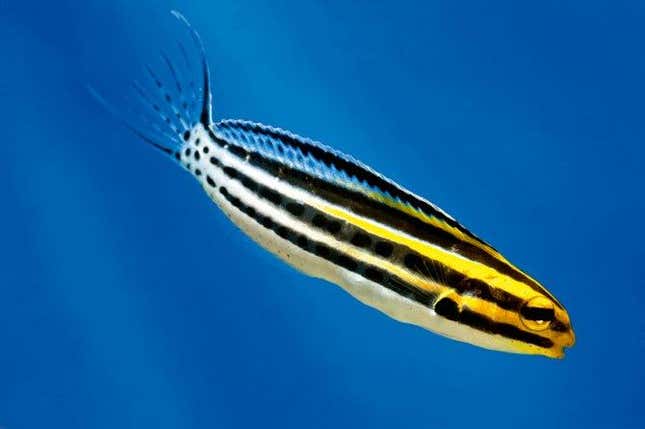To the untrained eye, the fang blenny, or Meiacanthus grammistes, is rather unremarkable. It’s black-and-white striped with a yellow head, and it only grows to be about 4 inches (10cm) long. Although it’s native to tropical Pacific waters, it’s commonly found in household aquariums.
But upon closer inspection, scientists discovered that fang blennies have a trait unlike any other animal. These fish bite predators and inject them with a concoction that includes opioid-like chemicals that may disorient them. While the would-be predator is dazed and confused, the blenny is able to swim away to safety.

A team of researchers based in Australia and England published (paywall) work on March 30 in Current Biology describing the unusual composition of blenny venom. “The fish injects other fish with opioid peptides that act like heroin or morphine, inhibiting pain rather than causing it,” Bryan Fry, a biologist studying venom evolution, at the University of Queensland in Australia and co-author of the paper, said in a statement. They believe that by further isolating its painkilling properties, they can possibly identify new chemicals to alleviate pain in humans.
In 1972, ichthyologist George Losey, on an expedition in Guam, stuck a blenny in his swim trunks because he didn’t have a proper container. The panicked blenny bit him just above his hip, and Losey reported only mild pain, like a bee sting. In predator fish like grouper, though, the venom caused a more visceral response (likely due to the fact that fish are much smaller). “The typical reaction after taking a M. atrodorsalis into the mouth was violent quivering of the head with distension of the jaws,” Losey wrote in a paper published that year (pdf). “The fish frequently remained in this distended posture for several seconds until the M. atrodorsalis emerged from their mouth. Frequently, the M. atrodorsalis were little harmed by the experience.”
When scientists studied the blenny’s venom itself (which was really difficult to do—milking any animal for venom is no easy task, let alone tiny tropical fish), they found there were three types of chemicals at work. One causes mild pain, explaining Losey’s discomfort when he was bitten. One causes rapid loss of blood pressure. And one seems to be a chemical similar to opioids, including prescription painkillers like Percocet and OxyContin and street drugs like heroin, which may explain why grouper seem so out of it after a blenny bite.
Not all researchers on the team are convinced the the blenny’s venom works like hard drugs. “These substances have to be released in the brain to have that type of activity,” Irina Vetter, a chemist studying pain at the University of Queensland, told the Atlantic. “It’s unlikely that they would relieve pain when we’re bitten by a fish because they can’t get into the brain that way.” If this is the case, it could be the plummeting blood pressure that stuns predators.
Still, Fry is optimistic that understanding the blenny’s venom could lead to the development of novel medicines. Already, researchers are looking to snails and Komodo dragons for different types of chemicals that can block pain or fight off infections, respectively.
